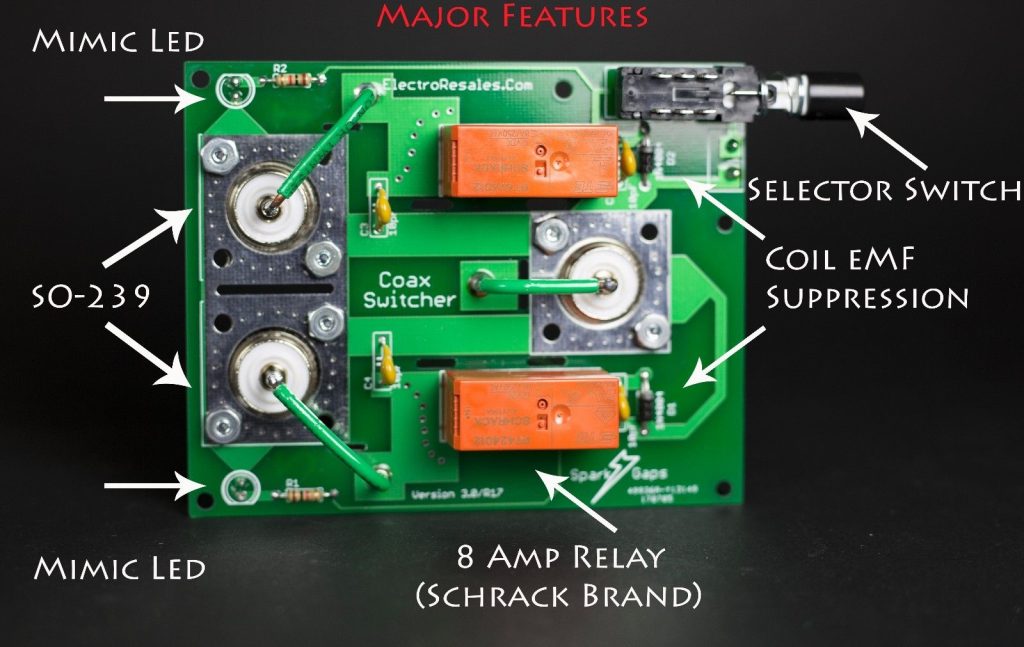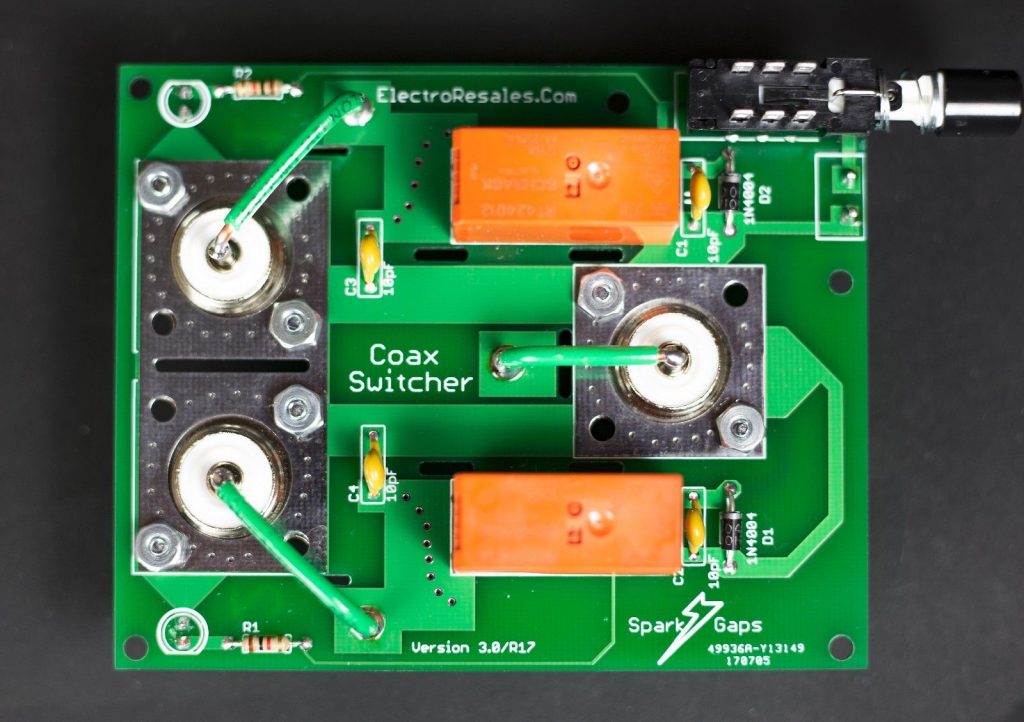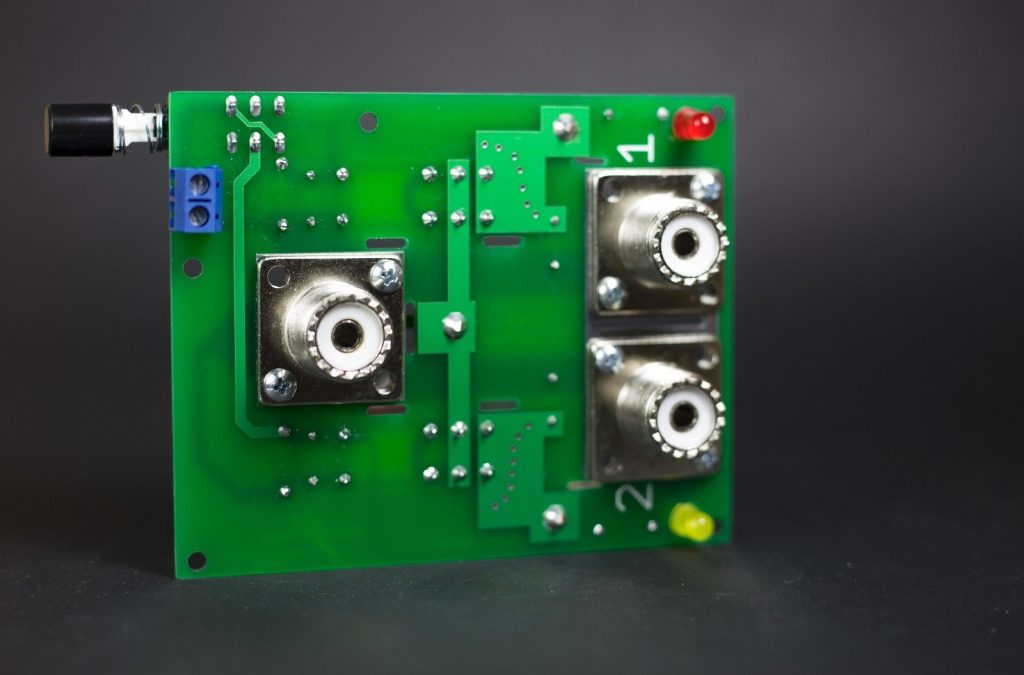Many thanks to Kenneth Crips who recently shared an eBay link to this antenna switch on the Gary J. Cohen’s Shortwave Listeners Global Facebook page.
The switch is not a kit–it is pre-built and appears to contain quality parts. The manufacturer, Electro Resales, makes a number of other products for the radio, astronomy, RC and model railroad markets. They have 99.9% positive feedback and a deep history of sales via eBay.
I’ve pasted the product description from eBay below:

Coaxial Electronic Switching unit for Antenna – 2:1 unit – Ready Built Unit
Switch 2 antenna to one radio or 2 radio to one antenna.
Using high quality Schrack Brand relays this antenna switcher works up to 200 MHz with SWR below 1:1 and minimal insertion loss.
Features include:
1. SO-239 input/output connectors
2. 8 Amp switching relay (Operation to 1 KW)
3. LED mimics indicate which port is active
4. Built in push switch for ease of operation – Selects relay coil to energize,
5. Remote installation operation possible
6. 1 KV Suppression capacitors and back EMF diodes on each relay coil
7. Relay coil : Capacitor tank frequency = 93 KHz – Minimizes RF interference on activation.
8. PCB Isolation Slots to minimize cross talk
9. 12 volt operation
10. Via stitching in critical signal paths and connector ground plane
11. Complete, self contained unit, ready to use. Not a Kit.PCB dimensions are 4″ x 3.25″ (100 mm x 80 mm). Ready to mount in your installation
Pictures illustrate actual item that you will receive.
Questions – Please ask – Free Shipping as always
Sale includes:
1. Finished PCB with all components
2. Link to our on-line user guidesNo other items such as power supplies, RF equipment or cables are included in the sale
I might purchase one of these as I have a remote antenna box with a solar-powered LDG ATU. This switch would allow me to change antennas without manually changing feed lines outside. I had planned to build a switch like this with my buddy, Vlado (N3CZ), but the price is awfully enticing! Have any SWLing Post readers purchased from this store before? If so, please comment.



I would consider buying the 6 antenna version from this buyer, but only if the SO239 connector grounds are isolated from each other. It doesn’t look like they are in the pictures of the PCB.
These grund connections are essential for electrical reaons. Otherwise you get quite large “coils” for the RF currents.
The only alternative would be a kit where the SO sockets have not been soldered so you could first mount the PCB on the inside and then the sockets from the outside.
My way would be kompletely different: Get a metal box, mount the SO sockets in an appropriate pattern and solder the relays between the sockets with the SO sockets as mounting points. For RF this would be good enough. For VHF/UHF the PCB would have to be constructed completely different in any case.
As I see it, you first need to do the rest of the development work:
1. Move the blue connector block to the other side of the PCB – unless you do not wish to do the second modification first:
2. Remove the switch and drill a hole for a three-connector terminal block. Connect both relay coils to the terminal block. for true remote switching.
3. See if you can drill holes through the PCB so you can mout the SO sockets correctly. Remember that you might screw a long, stiff RG-213 cable to these sockets.
The first modification is needed so you can mount the device into a housing. The switch is mounted in a way that you will have quite some problems to operate it in a housing. With the second modification you can mount the switch where you want.
Personally I would do it a bit differently: I would connect the center contact of the relay to the output and connect the NC contact to ground, The NO contact would be connected to the input.
That “RFI prevention” is a normal free-runing diode with a capacitor in parallel. As it is the capacitor does not help, on the contrary: When you switch on you get a rush current to load the capacitor. With a free-running diode in place I see absolutely no need for further RFI prevention. The inductor limits any rapid changes of currents and the free-running diode prevents any voltage peaks.
If the capacitor is sized correctly (dependant on the inductance of the relay coil) it can also decrease the slugging effect of the back-EMF clamp diode & reduce turn-off time (i.e. in this case the possibility of both antennas being connected for a short time). It was a pretty common technique in the old electromechanical telco days (post sleeve-slugged relays but before digital switches!)
IIRC, the old rule-of-thumb was to make the LC time constant 30% below the mechanical time constant / release speed of the relay…
Either diode or capacitor. If you need the diode to limit the voltage spike, the capacitor cannot work as you describe.
And yet, it does (if you’re just using a simple diode; not so much the case when using a TVS/transorb/etc) . Remember that the energy from the collapsing field has to go somewhere – with just a diode it circulates back into the relay coil, holding it up & increasing the release time. With the capacitor in parallel as well as the diode, part of the energy that would otherwise go to the coil flows to the capacitor, and so on and so on until the current through the relay coil dissipates to below holding levels.
In the case I outlined, the capacitor isn’t there as back-emf protection at all – it’s there to reduce the slow release caused by the back-emf diode. If it’s sized right – which, as I said, depends on both the inductance of the relay coil & mechanical speed of the relay – you can reduce the release time to near-normal while still gaining the benefit of the diode’s back-emf clamping. If it’s sized wrong… well, it can cause problems (e.g. both slow operate & even slower release).
As I hinted, it was a common enough technique in the days of relay-logic telco switching. Although probably something of a lost art, I’ve seen it mentioned in at least one relay datasheet from the likes of Omron / TE / etc. (If I can find that again I’ll post a link to it). Try it yourself sometime; the result may surprise you.
That said, the way I read the eBay ad is that the capacitors are there to reduce the higher frequency harmonic noise caused by the clamping/rectifying effect of the back-emf diodes…
Yes, I have the MFJ-4712 Antenna Switch. It’s fine for switching receive antennas, but I damaged the relays by transmitting 100W through it with relatively high VSWR. I now just run separate coax cable for different antennas and use a heavy duty manual switch in the radio room if needed. This works fine even for 1500W transmit power!
I think the Ebay version Antenna Switch would be fine for switching receive antennas, but I just won’t trust relays to switch high power levels typical of ham radio operation.
Noted! Thanks Steve.
MFJ makes a small two position remote antenna switch that sells for about $80, itcones compkete in a case suitable for mounting outdoors and does not require a power source at the switch end or control wires – it sends power down the coax feed line via a power injector.
MFJ-4712: http://www.mfjenterprises.com/Product.php?productid=MFJ-4712
Very cool, Ken! Thanks for sharing!
I’ve been using the MFJ remote switch for about 2 years now to switch between my longwire and J-Pole antennas. It works great, I would buy another one if needed.
Hi Ed,
Does your MFJ remote switch work OK below 1.8 MHz? I’m wondering if it inherently attenuates below this frequency (negating MW & LW DX), or if that was just marketing-speak to alert the hams that the device works fine from 160 meter band on upwards.
73, Guy
Hi Guy,
I guess I never thought about it before which tells me that when I’m switched to the wire I can tune from zero right through MW and HF. I know for a fact that if the antenna isn’t connected I don’t even get a noise level on the R-75 rig and I’ve never had that issue. I only use the longwire to receive.
The only problem I’ve had in 2 years was after a doozy of a T’storm a couple of months ago, turned the radio on and had nothing just like the antenna wasn’t connected. I thought the remote got fried but using the old adage “when in doubt reboot” I unplugged and re-plugged the remotes power and cycled the switch and was back in business. Hope this helps.
73, Ed
Thanks Ed! That’s very helpful. The switch described in the article looks well built and is attractively priced but it still needs an enclosure to protect it from the elements. Like DL4NO mentions, the PCB looks rather awkward for mounting in an enclosure.
The way it is now, the SO239 connectors would be jammed up against the inside of a housing with solder joints touching the case surface (OK if it’s plastic, but not the best construction practice). I’m not sure that enough threads of the connectors would be exposed on the outside of the box. Maybe the sockets can be spaced away from the PCB using longer bolts and spacers, and the enclosure surface sandwiched in between. The LEDs and terminal block would need to move, too.
If someone’s willing to put in the effort, the total cost with case and hardware would still be low. The MFJ-4712 is a ready-to-go solution though, with power sent up the coax also.